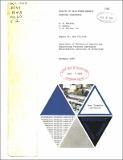Cooling of high-power-density computer components
Author(s)
Bergles A. E.; Bakhru, N.; Shires, J. W.
DownloadHTL_TR_1968_060.pdf (9.262Mb)
Other Contributors
Massachusetts Institute of Technology. Division of Sponsored Research.
Massachusetts Institute of Technology. Dept. of Mechanical Engineering.
Massachusetts Institute of Technology. Heat Transfer Laboratory.
Metadata
Show full item recordAbstract
This report summarizes work carried out during the first two years of a research program sponsored by IBM Corporation. This study has elucidated a number of the heat-transfer characteristics of several fluorochemicals which have potential application as coolants for high power density computer components. Single-phase heat-transfer coefficients have been determined for Freon-113 and FC-78 flowing in a rectangular channel with one of the wide sides heated. Heat-transfer coefficients for the short channels are significantly higher than those predicted by conventional correlations due to entrance effects and superimposed free convection. Uncertainties as to the actual values of certain thermophysical properties introduce corresponding uncertainty in correlation. Subcooled flow boiling data were taken with the rectangular channel for a wide variety of fluid-surface combinations, and over a wide range of flow conditions. These data should facilitate a close estimate of surface temperatures in actual systems. Data taken with an annular test section delineated hysteresis effects which were tentatively identified in the rectangular channel tests. Pool boiling tests indicated large temperature overshoots in the boiling curve with Freon-113. It was found that conventional correlations do not adequately describe critical heat flux data for horizontal circular heaters. The critical heat flux increases as diameter decreases, and increases as the wall thickness increases. The observed hysteresis effects in pool and flow boiling were examined in detail. It is suggested that the phenomenon of temperature overshoot hysteresis is due to two causes: a) the existence of metastable bubbles which are triggered only at sufficiently high disturbance level, and b) the deactivation of larger nucleation sites by displacing the vapor by liquid during subcooling. (cont.) Under conditions of low velocity or pool boiling, a) is probably most important, but at high velocity b) should be controlling. Increased heat-transfer coefficients observed prior to nucleation appear to be due to thermocapillary circulation induced by the metastable bubbles. It is demonstrated that a random array of Teflon pits on the surface is effective in augmenting heat transfer for pool boiling or low velocity flow boiling of water; however, there is no improvement in heat transfer with boiling of Freon-113 or FC-78. The mechanism of augmentation is examined from the standpoint of incipient boiling, and a plausible explanation for this behavior is suggested. An investigation of the factors controlling the void fraction for subcooled boiling was carried out with a horizontal visual section using Freon-113 and Freon TA. The observed point of net vapor generation was much farther upstream than that indicated by a recent prediction, due primarily to the dominance of the buoyant force. An examination of the void collapse in the unheated downstream portion of the tube revealed that bubble collapse theory cannot be used to predict the void fraction. The large void fractions produced by boiling fluorochemicals can be minimized by using twisted-tape inserts.
Date issued
1968Publisher
Cambridge, Mass. : M.I.T. Heat Transfer Laboratory, [1968]
Other identifiers
14090040
Series/Report no.
Technical report (Massachusetts Institute of Technology, Heat Transfer Laboratory) ; no. 60.
Keywords
Electronic apparatus and appliances -- Cooling., Heat -- Transmission.